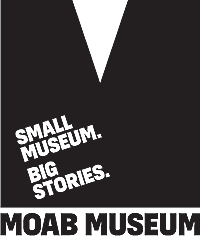|
|
MUSEUM
HAPPENINGS - April 2020
|
Make Full Use of All Available Sunshine
by Forrest Rodgers, Interim Executive Director, Moab Museum |
 The Covid-19 public health crisis that threatens the well-being of Moab residents, visitors, and area businesses is a reminder that sometimes history does repeat itself. In the summer of 1918, a lethal strain of influenza, dubbed the “Spanish Flu,” spread across the United States. Considered the worst epidemic in the history of the United States, the so-called Spanish Flu (Spain was not its source of origin) began just as World War I was winding down. The Covid-19 public health crisis that threatens the well-being of Moab residents, visitors, and area businesses is a reminder that sometimes history does repeat itself. In the summer of 1918, a lethal strain of influenza, dubbed the “Spanish Flu,” spread across the United States. Considered the worst epidemic in the history of the United States, the so-called Spanish Flu (Spain was not its source of origin) began just as World War I was winding down.
The flu first appeared in Utah in September and weeks later it arrived in Moab. When three members of the same family were diagnosed with the flu in mid-October, the State Board of Health shut down the small and remote town. “To Town Health Officers: You are hereby notified that in order to restrict the spread of influenza the State Board of Health has adopted the following order to be effective on and after October 10: Whenever the existence of a case of influenza is discovered in any town or school district, the following institutions and meetings shall be immediately closed and discontinued until further notice: Public and private schools, Sunday schools, colleges, business colleges, churches, theaters, moving picture houses, dance halls, public and private dances, pool halls, fraternal meetings, public funerals, and all other public assemblies.”
Fortunately, Dr. J.W. Williams was on duty. After completing his medical education at the unfortunately named Gross Medical College in Denver, “Doc” Williams responded to a newspaper ad and arrived in Moab soon after. Williams was familiar with the rough and tumble nature of small western towns and almost didn’t take the job out of concerns about making a living. But, the County Commission sealed the deal by also appointing him County Health Officer at the mighty salary of $150 per year. “Doc” served the vast reaches of sparsely populated Grand County from Cisco to Thompson to Moab, traveling to patients by foot, horseback, or wagon. When on horseback, he took medicines and supplies in a medical saddlebag that will soon be on exhibit at the Museum.
Williams helped spread the word about the State Board of Health’s recommendations and instructions for avoiding Spanish Flu: “Walk to work if possible. Wash your hands before eating. Keep out of crowded places. Walk in the open air. Sleep with the windows open. And, make full use of all available sunshine.”
As the flu spread throughout Grand and San Juan Counties, Moab was kept in strict quarantine. Travelers were either quarantined or sent away unless “Doc” determined they were in good health. Efforts to limit the flu’s impact had an immediate but short-term effect, and a second wave of infections hit the town in early 1919. But residents were ready and were encouraged to continue precautionary behavior and care. By the end of January two-thirds were infected with the flu or experienced complications from pneumonia, and at the epidemic’s end, only two deaths were recorded in Grand County.
So, does history repeat itself? In the face of the rapidly spreading flu epidemic of 1918, the preventative behaviors recommended by health officials then are similar to today’s Covid-19 pandemic response. Health officials in 1918 focused solely on human impacts, but since then Grand County’s population has grown five-fold with a local economy that is heavily dependent on visitors from all over the world. With the ban that requires all visitor accommodations and campgrounds remain closed, and that restaurants offer take-out orders only, it’s uncertain when and how Moab’s workforce and businesses will recover. But our community is a generous one – people of all ages are reaching out to help in as many ways as they safely can. And with our wide open spaces, social distancing is easier to accomplish. Locals can get outside in the unseasonable quiet of the desert to enjoy the health benefits of “all available sunshine.”
Editor’s Note: This articles draws heavily from Canyon Legacy articles written by Janet Lowe (Make Full Use of All Available Sunshine: Fighting the Spanish Influenza Epidemic of 1918) and Merry Lycett Harrison (Doc William’s Saddlebag and Its Contents).
Information on all events, activities, and exhibits are on our website moabmuseum.org and Facebook page! |
| |
|
|
|
|
|
|
© 2002-2024 Moab Happenings. All rights
reserved.
Reproduction of information contained in this site is
expressly prohibited.
|
|